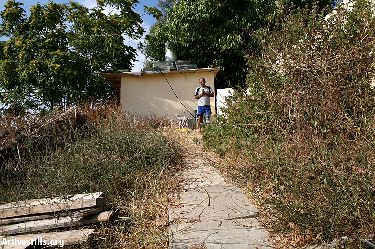.

Commentary;
What can one expect when an evil regime follows upon the precedents set in Gush Katif, the Shomron, Hevron’s Shalhevet neighborhood, Amona, etc.?
What this attack shows is that the Israeli government is as callous toward its Yemenite citizens now as they’ve been during the entire 60 years that these people have lived in the land. And it shows the indifference of most Israelis toward the plight of these residents, just as they were mainly indifferent to the former residents of Gush Katif. Further, it matters little on which side of the so-called “Greenline” one lives. Scary indeed! MB
Kfar Shalem: Gov’t Erred in 1948, Residents Pay Price Today
by Hillel Fendel (Israel National News)
“Dr. Sandy Kedar, a lawyer who teaches at Haifa University… though the eviction may be on solid ground in terms of dry law, ‘If you look at what is happening in Kfar Shalem and compare it, for example, to Kibbutz Galil Yam, then it can be argued that this is a discriminatory policy verging on illegality.'”
Excerpts;
A 43-year-old legal struggle is now one step away from its end after police and Border Guard forces evicted some 30 people from the Kfar Shalem neighborhood in Tel Aviv. Another 30 people still remain on what was once a 56-dunam (14-acre) disputed area.
A recent Supreme Court decision turning down the residents’ final appeal paved the way for the police to evict them from their homes on the privately-owned land. The police arrived in force early this morning (Tuesday), expecting violent opposition – but their fears were largely not actualized. Three protestors were arrested, but no major violence; the residents’ belongings were uneventfully loaded onto trucks – eyewitnesses at the site did not know where these trucks would be headed – and the buildings were gradually demolished, one by one.
The story began in 1948, when the newly-established State of Israel settled Jews from Yemen on the lands of what had been the hostile Arab village of Salama; Israeli forces had conquered the area in order to stop Arab sniper fire at the Jewish neighborhoods of Yad Eliyahu, Ezra and HaTikvah. The new Jewish neighborhood was named Kfar Shalem.
In 1965, the government passed a law stipulating relocation and compensation for the families, but it took years – and the killing by police of a resident during an attempted forced eviction in 1982 – before implementation of the law began. In the early 90’s, it was learned that part of the land was actually privately-owned by a British citizen, meaning that the government’s allocation of it to the new immigrants had been in error. Many of the families in Kfar Shalem were generously compensated by the State at that time when they were relocated to another area, but their neighbors living next-door were left out of the arrangement because their homes were on privately-owned parcels.
The legal situation became more entangled when a woman named Ruma Efrati purchased the land – at a discount, because of the fact that the land was occupied – and began to make plans to build a large housing complex there. After years of legal delays, the Supreme Court recently ruled that she may exercise her right to have the residents removed, regardless of whether the sides reach an agreement regarding compensation.
A Haaretz report of this past summer quotes Dr. Sandy Kedar, a lawyer who teaches at Haifa University, saying that though the eviction may be on solid ground in terms of dry law, “If you look at what is happening in Kfar Shalem and compare it, for example, to Kibbutz Galil Yam, then it can be argued that this is a discriminatory policy verging on illegality.” The reference is to a decision by the government earlier this year enabling residents of state-owned kibbutz land to sell the land for an enormous profit – while those of Kfar Shalem are given nothing.
A staffer at the Tel Aviv Municipality Spokesman’s office told Arutz-7 that it had no statement to make, as it it not a party to the dispute. Asked if the municipality would aid the displaced residents, she said, “Those who need help will receive it; representatives of our social welfare department were at the site today.”